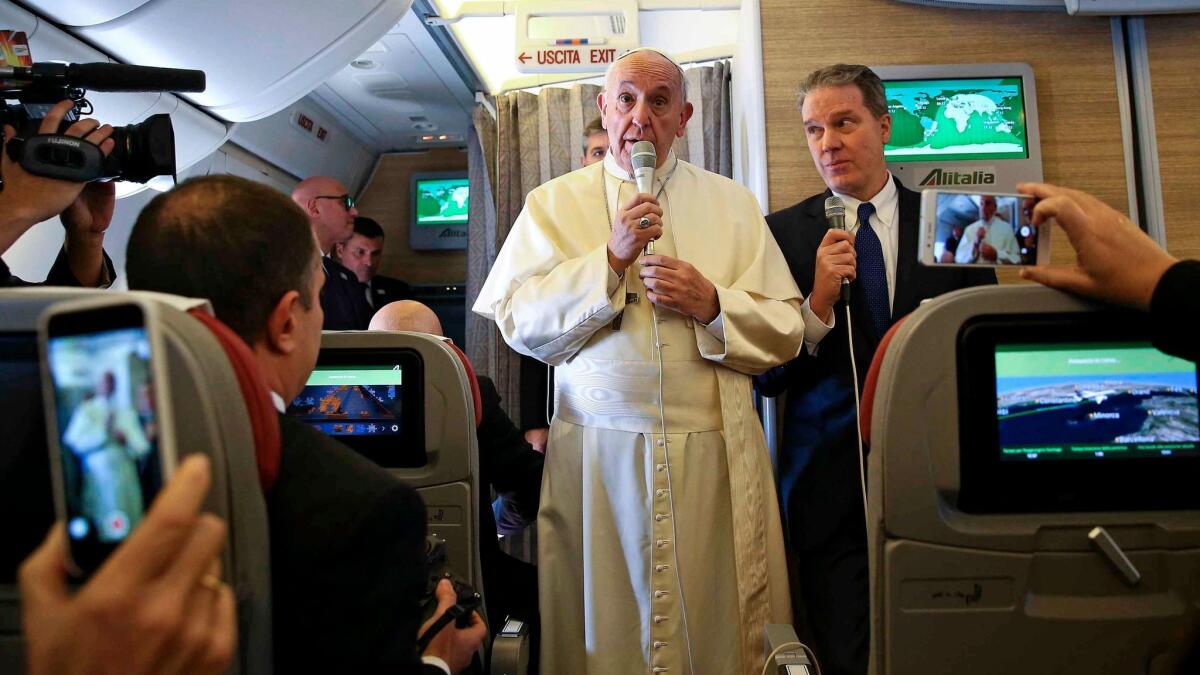Pope Francis arrives in Chile for weeklong trip focused on the poor, the rainforest and indigenous people

- Share via
Reporting from Santiago, Chile — Pope Francis arrived here in the Chilean capital Monday evening to start a weeklong swing through Chile and Peru in which he is expected to highlight the plight of indigenous peoples, the destruction of the Amazon rainforest and the precarious status of immigrants and the poor.
In an eleventh-hour schedule shift, Francis stopped in Santiago at the tomb of a Chilean prelate who was known as the “bishop of the poor” and who aided those seeking loved ones detained during Chile’s former military dictatorship.
Francis was welcomed at Santiago’s international airport by Chilean President Michelle Bachelet. A children’s orchestra celebrated his arrival on the tarmac as the pope, who was born in neighboring Argentina, listened with a broad smile and an aide held his cassock against a blustery wind.
The 81-year-old pope, known for his low-key style, took the passenger seat of a blue Hyundai sedan. The car traveled from the airport through the streets of the capital in a convoy of white SUVs as tens of thousands of well-wishers, many waving Vatican and Chilean flags, lined the streets.
His first stop, in the working-class Pudahuel district at the tomb of Chilean Bishop Enrique Alvear Urrutia, the bishop of the poor, seemed fitting.
When Francis became pope in 2013, he vowed to lead a “poor church for the poor,” embracing the values that many here say Alvear embodied.
Alvear, who died in 1982 and is a candidate for sainthood, was a fierce defender of human rights, notably during the initial years of the military dictatorship that ruled from 1973 to 1990 and was headed by Gen. Augusto Pinochet. It was an epoch when many assailed the church leadership for failing to speak out against the abuses of the government.
But Alvear was undeterred, despite death threats and the constant risk of arrest.
He would show up at detention and torture centers — including the notorious Villa Grimaldi in Santiago — in search of the “disappeared.”
The stop at the bishop’s tomb, announced shortly before the papal plane left Rome for Santiago, raised the question of whether Francis will speak about the victims of the dictatorship during his visit.
The Latin American church has long featured both conservative, pro-establishment tendencies and social activist elements, occasionally leading to tension within its hierarchy.
Pinochet’s legacy is still a deeply divisive issue in Chile, which remains a highly conservative, predominantly Roman Catholic country, despite the growth of Protestant evangelical sects.
On Monday evening, Francis switched from the Hyundai to the popemobile during a ride through central Santiago.
Outside the apostolic nunciature, where he was to spend the evening, he embraced and bestowed blessings on adults and children — including a disabled boy — gathered there and received flowers and other gifts from well-wishers. He took off his white skullcap, or zucchetto, to put on one offered by a boy, then returned it to the boy and placed his own back on his head. Ecstatic Chileans who had waited for hours recorded the pope on their cellphones.
Francis begins a full schedule of public events Tuesday, which features a morning Mass at O’Higgins Park in central Santiago. The pope’s homily at the service is expected to be his first major address during the trip.
On Wednesday, he heads to the southern city of Temuco, a center of Chile’s Mapuche indigenous population. The pope is expected to address the Mapuches’ struggle for the recuperation of ancestral lands and other rights.
A series of firebombings at Roman Catholic churches in the Santiago area preceded the pope’s arrival. Authorities downplayed the incidents, which caused minor damage and no injuries. Police have not named suspects in the attacks.
Victims of sexual abuse by priests — an issue that has shaken the Catholic Church at its core over the last two decades — have sought a meeting with the pope. But no such session has yet been scheduled.
On Thursday, the papal visit switches to Peru, where the pope is scheduled to travel to the city of Puerto Maldonado, the gateway to Peru’s Amazon region and a center of illicit gold mining that has ravaged the environment and forced many from their homes.
The weeklong papal visit concludes on Jan. 21 in Lima, the Peruvian capital, where the pope will recite the Angelus prayer at noon in Plaza de Armas, in the city’s historic center.
The trip is the fourth to South America for Francis, the only pope born in the Americas.
On the papal plane en route to Chile, Francis distributed to reporters a disturbing black-and-white photo of a child who, after the U.S. atomic bombardment of Nagasaki in 1945, carries his dead brother on his shoulders to a crematorium. The boy is barefoot, his lips are tightly sealed, and he stands at attention, with his dead brother strapped onto his back. The pope told reporters said he was “very moved” by the photo, taken by a U.S. photographer, Joseph Roger O’Donnell.
The pontiff, who has backed the banning of nuclear weapons, captioned the photo “The Fruit of War.”
Times staff writer Tracy Wilkinson in Washington and special correspondent Jorge Poblete in Santiago contributed to this report.
Twitter: @PmcdonnellLAT
More to Read
Sign up for Essential California
The most important California stories and recommendations in your inbox every morning.
You may occasionally receive promotional content from the Los Angeles Times.












